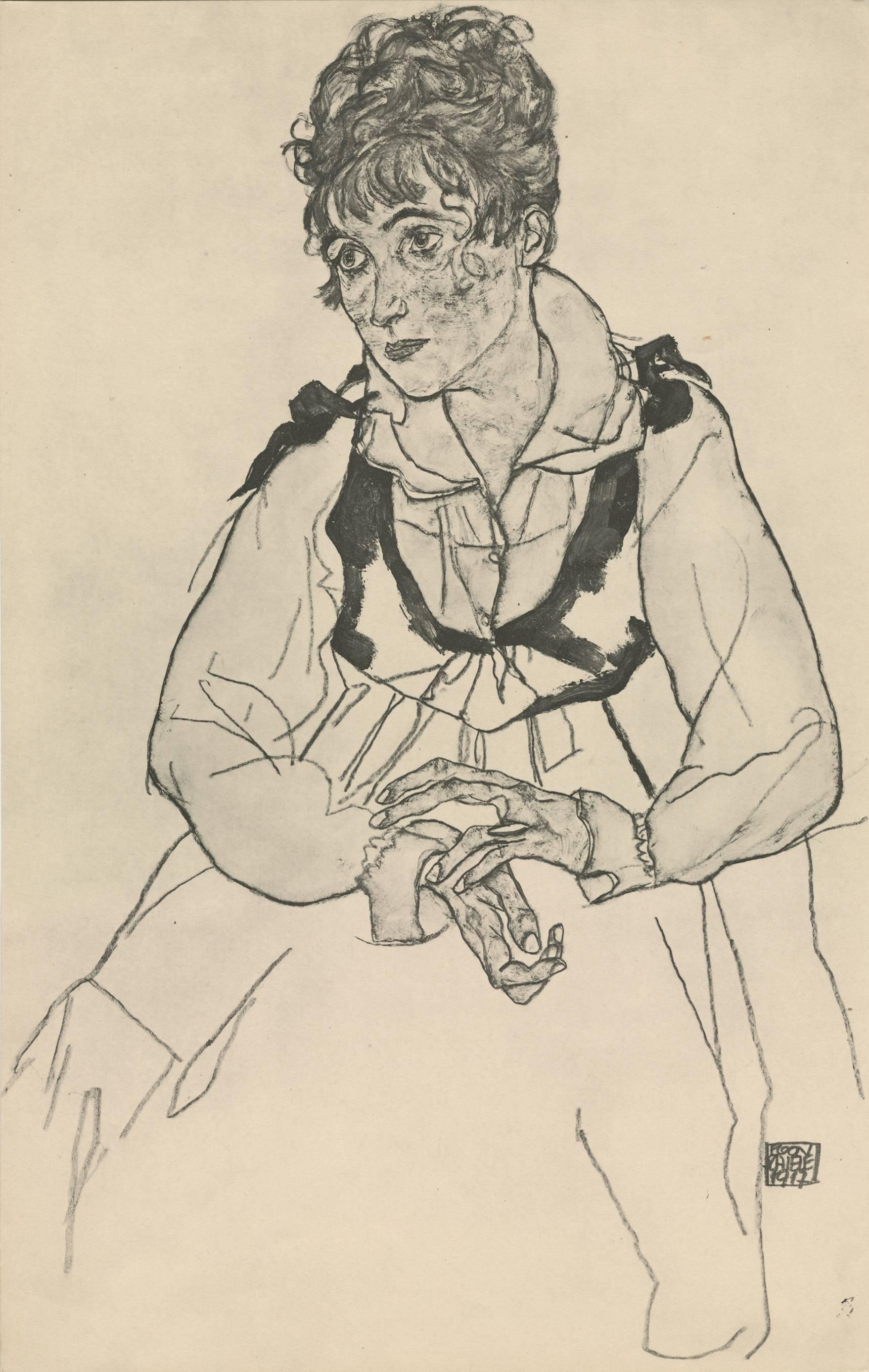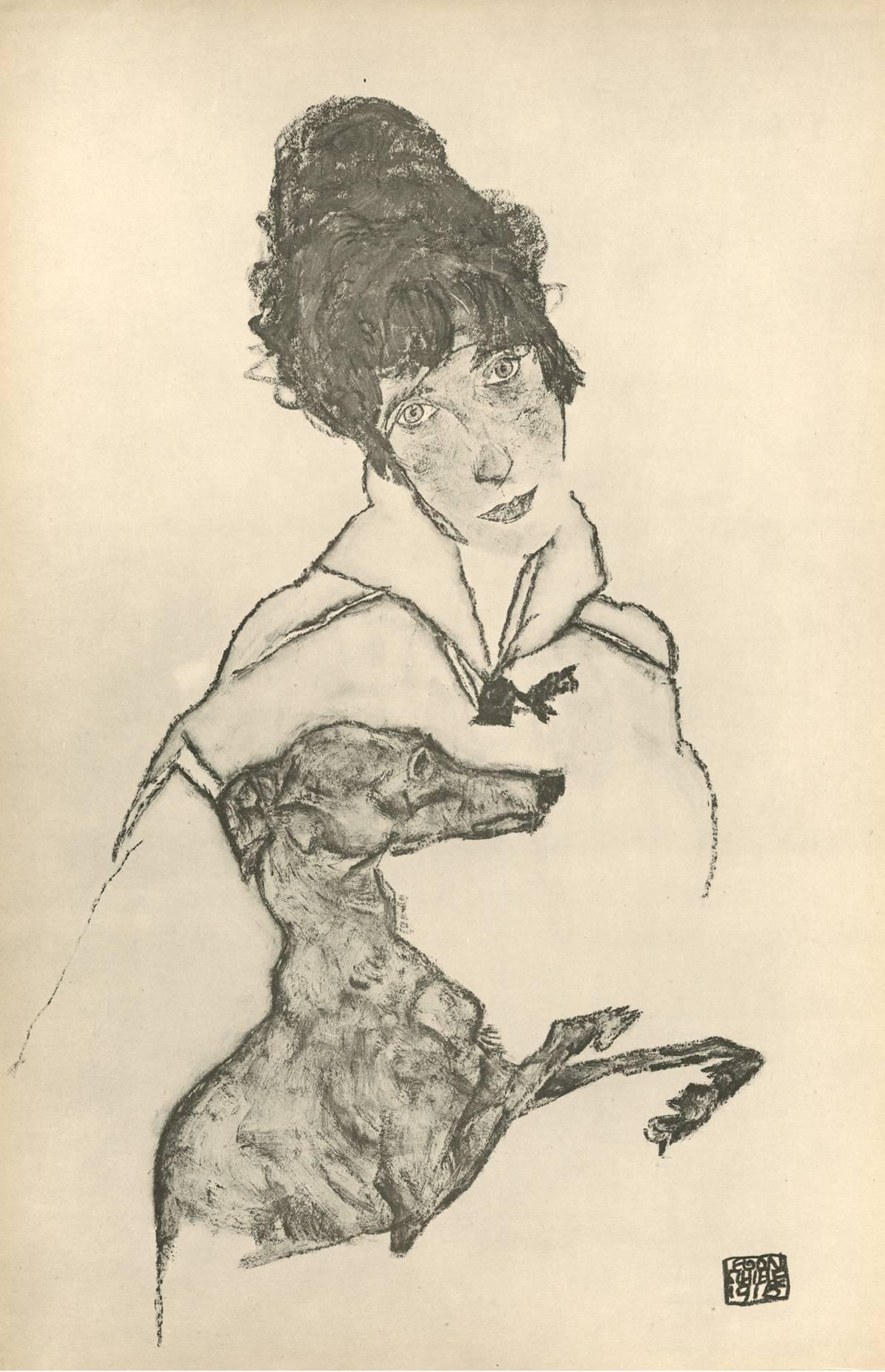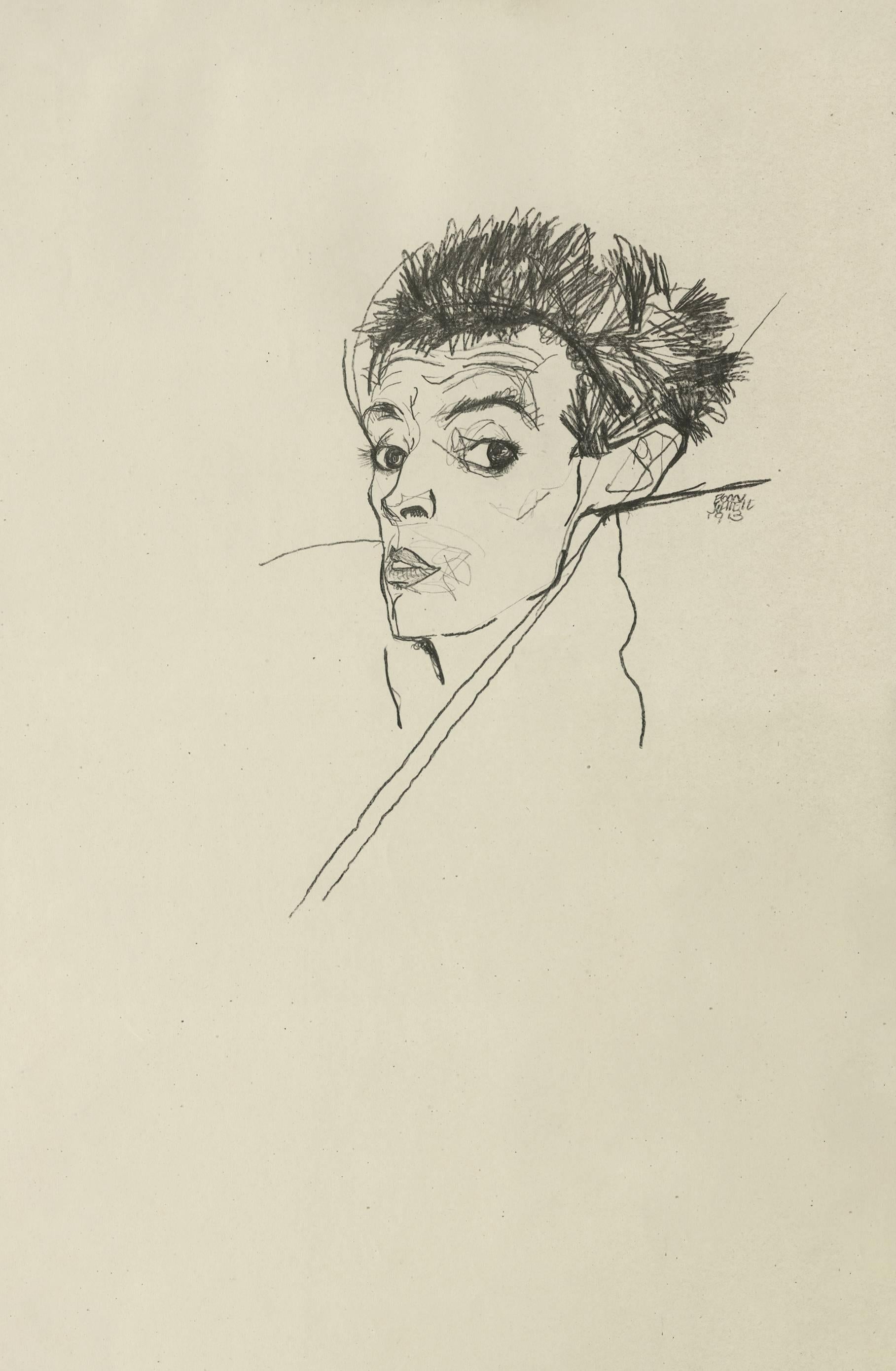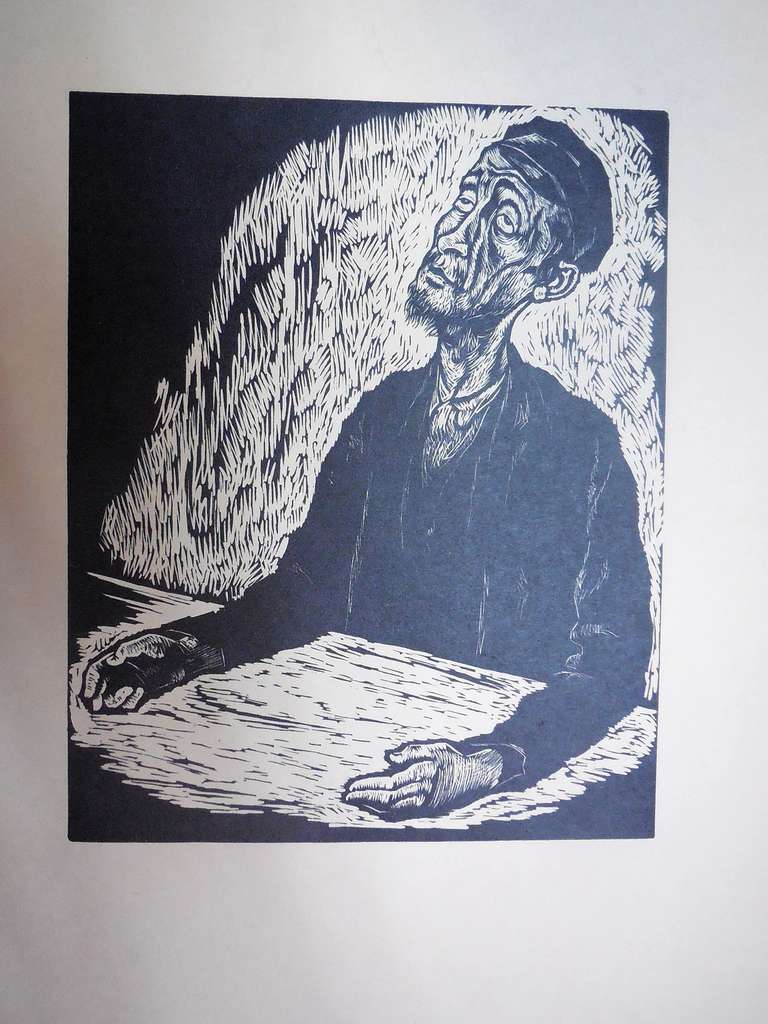Items Similar to R. Layni, Zeichnungen folio, "One-Year-Volunteer Private" Collotype plate V
Want more images or videos?
Request additional images or videos from the seller
1 of 6
(after) Egon Schiele & Max JaffeR. Layni, Zeichnungen folio, "One-Year-Volunteer Private" Collotype plate V1917
1917
About the Item
Egon Schiele (1890 – 1918), AUSTRIA
“ART CANNOT BE MODERN, ART IS PRIMORDIALLY ETERNAL.” -SCHIELE
Defiantly iconoclastic in life and art, Egon Schiele is esteemed for his masterful draftsmanship and precocious insight into the human condition. Part of the first wave of Austrian Modernism, he was swept away by the Viennese fascination with the tension between Life and Death (known in the works of Freud and his later interpreters as Eros and Thanatos). Life, identified with attraction, love, sexuality, and reproduction, and Death, represented by distortion, disease, repulsion, and hysteria, often appeared in the same composition, thereby suggesting the frightening life cycle of the human mind and body.
Young throughout his career, Schiele universalized his childhood traumas, thriving libido, insecurities, fears, and longings. His contorted line, jarring contrasts, and flat areas of color, demonstrate an early alliance with Expressionist philosophy and artists who were relentlessly frustrated by conventionality in all its forms. Schiele’s work embodied man’s disorientation and confusion in a seemingly absurd world, a world plagued by disease and war. It continues to be astonishingly relevant today, not just because it helped define Modernism but also because it revealed the dark and immutable aspects of the human condition.
Zeichnungen is a fine art print portfolio published by Verlag der Buchhandlung Richard Lanyi, Vienna, 1917, printed by Max Jaffe in an edition of 400 under the supervision of Egon Schiele. The plates and negatives of the 12 printed images of original watercolors and drawings by Schiele were destroyed after the run. Included with the 12 unbound sheets of mono-chromatic printed images was a Title Page and essay about Schiele’s work printed verso and a Justification Page listing the 12 untitled works’ owners and dates created. At the bottom of the Justification page, Schiele hand-signed, dated and numbered each copy. The collection came in a string-tied box whose cover displayed a printed self-portrait by Schiele.
Often cast as an enfant terrible, who was imprisoned in 1912 for publicly displaying lewd erotic-based paintings and drawings, Egon Schiele (1890-1918) was in actuality a central figure of the avant-garde at the time this portfolio was printed. Schiele’s Zeichnungen portfolio provides a rare example of the existing link between Schiele, the iconic artist, and his Viennese cultural milieu. As expressed in the portfolio’s text, Schiele's hand joined so many ways of seeing to capture the erotic, the intellectual, the esthetic. In the early years of 20th century Vienna, there was no clear separation between fine art, science, sociology and politics or philosophy; the cross-pollinating character of Viennese intellectual life was robust. Rather than cut off and confined to the university, intellectual activity thrived in social spheres such as coffee houses and salons. Huge overlap existed among these interdisciplinary circles. In a city number-ing approximately 2 million, only a few hundred comprised the cultural and political elite. Schiele exhibited widely, helped to organize exhibitions and had earned such a following that upon the death of Gustav Klimt in February the year following Zeichnungen’s publication, Schiele had naturally taken up the torch as Klimt’s successor. As leader of the 49th Vienna Secession Exhibition in 1918, the responsibility to create an exhibition poster and art for the main gallery fell on Schiele’s shoulders. Critical accolades for his Expressionist work made certain Schiele’s leading position in the world of art. At the height of this success, however; Schiele’s life was cut short by Spanish Influenza. He died at the age of 28. Shiele’s Zeichnungen portfolio is all the more valuable as an art piece which was realized during his protracted lifetime as well as for the key insights it provides into the intellectual circles which characterized early 20th century Vienna. Schiele’s portfolio was a picture of Vienna, itself: a collaboration between fine artist; art collectors; art promotors; idea disseminators; scientists; and printers.
Buchhandlung Richard Lanyi, whose publishing branch of the business published Schiele’s Zeichnungen portfolio, was indeed one of these significant cultural spheres and places to gather. On its first floor was the bookstore and lecture room. Notable Sociologist, Karl Kraus, was a regular there. On the second floor, Lanyi housed a veritable overflow of prints, portfolios and original art works by Klimt, Kokoschka, and others including Schiele. Artists and intellectuals from many disciplines quite literally rubbed shoulders in this intimate space with the likes of wealthy industrialists. Art held a unique place within this social setting. Certainly, it was collected as a symbol of status and displayed in homes by the wealthy elite. Art also served a dual purpose; within these intellectual social spheres, art was a form of scholarship. Art was conversation and fodder for the promulgation of ideas within multi-disciplinary areas of intellectual and cultural interest. It was intended to be shared. A portfolio of images re-producing works of art which were not widely accessible, by nature of their permanent locations and the cumbersomeness to move them, was therefore an especially important contribution to the dynamic inner workings of Viennese high culture. Schiele’s Zeichnungen quickly sold out. It is a testament to the level of interest for Schiele’s work among these closely-knit circles of collectors as well as a fine example of the vigorous intellectual culture which existed generally in Vienna at the time.
The collotype print form was at this time the preferred method of reproducing fine works of art. The printer of Schiele’s Zeichnungen portfolio was Max Jaffe, a Viennese specialist in fine art collotypes. This dichromate-based photographic process had been invented in 1856. The gelatin plates required delicate preparation involving light exposure, washing, and curing. They were inked with a velvet or leather roller and printed using a hand proof process with a light-pressured press. Collotype plates could not be re-used; the limited edition prints made from colloid inks were stable and posed no danger of fading like other photographic processes of the time. In fact, the fine reticulations created on the plates using the collotype process produced prints of extremely high quality.
- Creator:(after) Egon Schiele & Max Jaffe (1890 - 1918)
- Creation Year:1917
- Dimensions:Height: 19.13 in (48.6 cm)Width: 12.25 in (31.12 cm)
- Medium:
- Movement & Style:
- Period:
- Condition:Literature: "Egon Schiele: The Complete Works" by Jane Kallir. 1990. Pg. 564 (#1849).
- Gallery Location:Chicago, IL
- Reference Number:1stDibs: LU46736447242

About the Seller
5.0
Gold Seller
These expertly vetted sellers are highly rated and consistently exceed customer expectations.
Established in 2013
1stDibs seller since 2016
82 sales on 1stDibs
Typical response time: 2 hours
- ShippingRetrieving quote...Ships From: Chicago, IL
- Return PolicyA return for this item may be initiated within 3 days of delivery.
More From This SellerView All
- R. Layni, Zeichnungen folio, "The Artist's Wife, Seated" Collotype plate VILocated in Chicago, ILEgon Schiele (1890 – 1918), AUSTRIA “ART CANNOT BE MODERN, ART IS PRIMORDIALLY ETERNAL.” -SCHIELE Defiantly iconoclastic in life and art, Egon Schiele is esteemed for his masterfu...Category
1910s Vienna Secession Portrait Prints
MaterialsPaper
- E. Strache, Handzeichnungen folio, "Portrait Study (Head of a Girl)" CollotypeBy (after) Egon SchieleLocated in Chicago, ILafter Egon Schiele (1890 – 1918), AUSTRIA “ART CANNOT BE MODERN, ART IS PRIMORDIALLY ETERNAL.” -SCHIELE Defiantly iconoclastic in life and art, Egon Schiele is esteemed for his mas...Category
1920s Vienna Secession Portrait Prints
MaterialsPaper
- R. Layni, Zeichnungen folio, "Woman with Greyhound" Collotype plate IIILocated in Chicago, ILEgon Schiele (1890 – 1918), AUSTRIA “ART CANNOT BE MODERN, ART IS PRIMORDIALLY ETERNAL.” -SCHIELE Defiantly iconoclastic in life and art, Egon Schiele is esteemed for his masterful...Category
1910s Vienna Secession Portrait Prints
MaterialsPaper
- E. Strache, Handzeichnungen folio, "Self-Portrait" Collotype plateBy (after) Egon SchieleLocated in Chicago, ILafter Egon Schiele (1890 – 1918), AUSTRIA “ART CANNOT BE MODERN, ART IS PRIMORDIALLY ETERNAL.” -SCHIELE Defiantly iconoclastic in life and art, Egon Schiele is esteemed for his mas...Category
1920s Vienna Secession Portrait Prints
MaterialsPaper
- H.O. Miethke Das Werk folio "Farm House in Buchberg" collotype printBy Gustav Klimt & K.K. Hof-und StaatsdruckereiLocated in Chicago, ILDAS WERK GUSTAV KLIMTS, a portfolio of 50 prints, ten of which are multicolor collotypes on chine colle paper laid down on hand-made heavy cream wove paper with deckled edges; under ...Category
Early 1900s Vienna Secession Landscape Prints
MaterialsPaper
- Max Eisler Eine Nachlese folio “Church on Lake Wolfgang” collotype printBy (after) Gustav KlimtLocated in Chicago, ILAfter Gustav Klimt, Max Eisler #28, Kirche am Wolfgangsee; multi-color collotype after 1915/16 painting in oil on canvas. GUSTAV KLIMT EINE NACHLESE (GUSTAV KLIMT AN AFTERMATH), a portfolio of 30 collotypes prints, 15 are multi-color and 15 are monochrome, on chine colle paper laid down on heavy cream-wove paper with deckled edges; Max Eisler, Editor-Publisher; Osterreichischer Staatsdruckerei (Austrian State Printing Office), Printer; in a limited edition of 500 numbered examples of which: 200 were printed in German, 150 were printed in French and 150 were printed in English; Vienna, 1931. 2018 marks the 100th anniversary of Gustav Klimt’s death. It is a fitting time to reflect upon the enduring legacy and deep impact of his art. Recognizing this need for posterity with uncanny foresight, the publication of Gustav Klimt: An Aftermath (Eine Nachlese) provides a rare collection of work after Klimt which has proven to be an indispensable tool for Klimt scholarship as well as a source for pure visual delight. Approximately 25 percent of the original works featured in the Aftermath portfolio have since been lost. Of those 30, six were destroyed by fire on 8 May 1945. On that fateful final day of WWII, the retreating Feldherrnhalle, a tank division of the German Army, set fire to the Schloss Immendorf which was a 16th century castle in Lower Austria used between 1942-1945 to store objects of art. All three of Klimt’s Faculty Paintings: Philosophy, Medicine and Jurisprudence (1900-1907), originally created for the University of Vienna, were on premises at that time. Also among the inventory of Klimt paintings in storage there was art which had been confiscated by the Nazis. One of the most significant confiscated collections was the Lederer collection which featured many works by Gustav Klimt such as Girlfriends II and Garden Path with Chickens. In many instances, Aftermath is our only link to these lost treasures. Max Eisler (1881-1937), the publisher of the 1931 Aftermath portfolio, was an art historian at Vienna University specializing in modern and contemporary arts and crafts whose 1920 book on Klimt was the first Klimt monograph. He saw An Aftermath as filling-in important gaps left by the earlier print portfolios which had only featured Klimt up to 1913 and which had glossed over major art projects such as the Tree of Life frieze for the Palais Stoclet. And whereas only 10 of the 50 prints from the earlier portfolios published by H.O. Miethke were made in intricate multi-color images, Eisler augmented the earlier format by featuring half of the 30 images in stunning multi-colored collotypes. Understanding the fragile nature of the collotype printing process also reinforces this project’s distinctive and exceptional characteristics. Fragile collotype plates can not be reused. As such, this necessitates the completion of a run on the first go and also dictates a limited production number. Printed by hand, the collotypes required deft handling by the printer, Osterreichische Staatsdruckerei. A complicated and lengthy process involving gelatin colloids mixed with dichromates, the creation of 16 color separation thin glass filters to achieve the light-sensitive internegative images which could faithfully capture all of the painting’s tonal gradations and colors, exposure to actinic light, and delicate chine collie papers which allowed for greater color saturation, the printer’s collaborative role in capturing and transmitting Klimt’s nuanced paint strokes is nothing short of remarkable. The Österreichische Staatsdruckerei (Austrian State Printing Office), was the successor to the KK Hof -und Staatsdruckerei which was founded by Emperor Franz I...Category
1930s Vienna Secession Landscape Prints
MaterialsPaper
You May Also Like
- Original Vintage Secession Poster celebrating the emperor's jubileeLocated in Zurich, CHOriginal Vintage Poster by the Austrian artist Ferdinand Ludwig Graf, a member of the Hagenbund. This Viennese artist association moved as soon a...Category
Early 1900s Vienna Secession Figurative Prints
MaterialsPaper
- Expressionist PortraitBy Arthur KolnikLocated in Surfside, FLArthur Kolnik was born in Stanislavov, a small town in Galicia, which was then part of the Austro-Hungarian Empire. His father, who was originally from Lithuania, worked as an accoun...Category
1930s Expressionist Portrait Prints
MaterialsPaper
- Homage a Leonard de Vinci-Front. Self-portrait of de VinciBy Claude WeisbuchLocated in Milwaukee, WIThis is an original color lithograph created by Claude Weisbuch. It was designed to promote his show at Vision Nouvelle, a gallery in France. This show in particular was about his Ho...Category
1970s Expressionist Prints and Multiples
MaterialsLithograph, Paper
- Aria II, Rosie Emerson, Limited Edition Print, Affordable Artwork, Still LifeBy Rosie EmersonLocated in Deddington, GB‘Aria’, the accompanied solo performance in an Opera, also means Air in Italian is a fitting title for these brand new ethereal works, they work well in pairs or a set of three. The ...Category
21st Century and Contemporary Expressionist Portrait Prints
MaterialsPaper, Etching
- Transcend, Kate Willows, Limited Edition Print, Angelic Artwork, Affordable ArtLocated in Deddington, GBTranscend by Kate Willows [2017] limited edition Ink on paper Edition of 40 Image size: H:30 cm x W:20 cm Sold Unframed Please note that insitu image...Category
21st Century and Contemporary Expressionist Portrait Prints
MaterialsPaper, Ink
- The Chess Game Texture Print By Renowned Italian Artist Francesco BedaBy Francesco BedaLocated in LOS ANGELES, CA**ANNUAL SUPER SALE UNTIL APRIL 15TH ONLY** *This Price Won't Be Repeated Again This Year-Take Advantage Of It* RESTORED, numbered and RARE Vintage Textured Print Aft...Category
16th Century Expressionist Portrait Prints
MaterialsHandmade Paper





